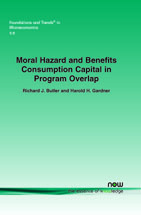Moral Hazard and Benefits Consumption Capital in Program Overlap: The Case of Workers' Compensation
By Richard J. Butler, Brigham Young University, USA, richard_butler@byu.edu | Harold H. Gardner, HCMS Group, USA, hgardner@hcmsgroup.com
Abstract
In this paper we review and extend the analysis of moral hazard response in two relatively unexamined empirical directions: (1) how insurance changes in one program affects employee participation in other programs at a point in time (inter-program moral hazard), and (2) how the consumption of program benefits now tends to affect employees behavior over time (benefits consumption capital). We develop a formal model of inter-program moral hazard based on workers' compensation with programs overlapping it (including sick leave, health insurance, and unemployment insurance), and review evidence concerning this overlap response. We also provide new evidence on benefits consumption capital concerning workers' compensation using data from one large private employer in the US.
Moral Hazard and Benefits Consumption Capital in Program Overlap
Moral Hazard and Benefits Consumption Capital in Program Overlap reviews and extends the analysis of moral hazard response in two empirical directions: 1) how insurance changes in one program affects employee participation in other programs at a point in time (inter-program moral hazard), and 2) how the consumption of program benefits now tends to affect employees behavior over time (benefits consumption capital). The authors focus principally on workers compensation and programs that overlap with potential workers compensation coverage to keep institutional issues to a manageable level. This will not only include employer-provided health/health care insurance, short and long term disability insurance, and Federal benefits under the social security disability program, but also Federal benefits paid under unemployment insurance.
